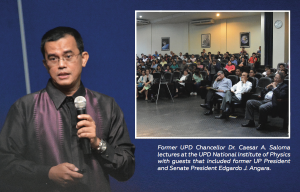Pouring outlay into research and development (R&D) should be a sound investment for economic growth. After all, scientific knowledge, when discovered and applied successfully, boosts labor productivity, creates wealth and enhances quality of life. The Philippines followed this premise by increasing budget allocation in the Department of Science and Technology (DOST) by 115.11 percent from 2009 to 2014. But why is the Philippines still dismally behind Singapore, Brunei Darussalam, Malaysia, Thailand and Indonesia in terms of Gross Domestic Product (GDP) per capita?
Merely increasing budget for R&D, says Caesar Saloma, is not enough. “Proper appreciation of the absorption capacity of the scientific enterprise system is crucial for our political leaders, policy makers and socio-economic managers if future investments in R&D are to generate proportional improvements in national prosperity and quality of life in Philippine society. The task is particularly urgent when public funds are used to fund R&D activities,” he explained.
So it isn’t just about how much we put in; it’s also about whether we can efficiently and strategically use it. Saloma, professor at the National Institute of Physics in the University of the Philippines Diliman, devised several indices to gauge whether the inputs of the scientific enterprise system generate corresponding outputs in terms of research productivity, through peer-reviewed publications, and human resource generation, through PhD graduates per year.
The Philippine scientific enterprise system, describes Saloma, refers to the institutions and organizations in the country that are directly involved in the training of future scientists and researchers in the various disciplines of basic, applied and social sciences, technology, engineering and mathematics or STEM.
Key to Saloma’s analyses is developing the indices of the scientific enterprise system – the Academic Productivity Index (API), the Scientific Productivity Index (SPI) and the PhD Production Efficiency Index (PPEI) – on a per capita basis.
This premise allowed Saloma to discover, for example, that GDP per capita (national prosperity) needs to reach a threshold before it starts correlating with publications per capita (research productivity) which is the case for Singapore, Malaysia and Thailand.
In money terms, the threshold that the Philippines needed to break away from in 2015 was approximately USD 5,000 GDP per capita, said Saloma, stressing that only until GDP per capita far exceeds that figure will national investments in R&D make a difference.
For this to happen, the prudent and realistic approach is to create an enabling environment that will allow R&D investments to flourish. Developing basic infrastructure, improving goods market efficiency, establishing technological readiness and ensuring greater access to information will directly enhance global competitiveness, and later, R&D competitiveness.
The API, SPI and PPEI are essentially indicators of the conduciveness of environments for R&D activities; the higher the scores, the better the R&D environments. Requisite to successful R&D environments are strategically placed inputs to produce quality outputs of the scientific enterprise system.
Analyzing API, SPI and PPEI scores across degree programs and academic institutions of higher learning can tell us how to be strategic.
Saloma notes: “The DOST must provide full PhD scholarships to qualified students in the social sciences and economics while sustaining its support to PhD degree programs in STEM. The challenges that our country is facing regarding the impact of extreme weather events and income inequality, for example, are best addressed by collaborating experts from various disciplines.”
Spend public funds wisely. The findings bring to light the difficulties of government procurement for R&D initiatives that use public funds. Saloma strongly suggests that the DOST and UP collaborate and formulate a separate procurement system governing the use of public funds in scientific R&D activities in the country for Engineering Reseach and Development for Technology (ERDT) and Accelerated Science and Technology Human Resource Development Program (ASTHRDP) member-institutions.
The said system can feature a separate set of Implementing Rules and Regulations of Republic Act 9184: The Government Procurement Reform Act that was signed into law in January 2003.
Salient features of the recommended R&D procurement system can include a depreciation formula for research facilities, equipment, devices and components; granted permissions to import equipment and technical services from internationally recognized and established manufacturers and service providers free of tax and custom duties; and, automatic regular adjustment of the price ceiling for shopping and small-value procurement that factors in variations in inflation rate, consumer price index and foreign exchange rate.
At an individual level, API, SPI and PPEI scores also bring to light the strategic mechanisms needed for the recognition and proper support of faculty, students and administrators.
Saloma says that the employment of analytics for purposes of promotion in academic rank and granting of permanent appointments for tenure and professor emeritus status is critical in building an enabling ecosystem of higher education institutions, as it becomes grounded in the tenets of transparency, predictability and meritocracy.
“It will motivate the faculty, staff and administrators to work together for a common purpose that is larger than the sum of their own individual aspirations,” Saloma adds.
Saloma presented these findings at a public lecture supported by the UP President Edgardo J. Angara Fellowship Program managed by the Office of the UP President through the Center for Integrative and Development Studies of the University of the Philippines last Jul. 19 at the National Institute of Physics in UP Diliman, Quezon City. Dr. Ernesto Pernia, Secretary for Socio-Economic Planning and NEDA Director-General, and Dr. William Padolina, NAST President, were discussants of the public lecture. More details of the public lecture can be found at http://cids.up.edu.ph/can-ph-improve-science-enterprise/.
*Maureen Anne Araneta is an assistant professor at the College of Architecture in UP Diliman. She graduated BS Architecture in UP Diliman, holds a masters degree for Urban and Regional Planning, and is currently studying for a PhD in Anthropology at the UP College of Social Sciences and Philosophy. The article was first published in “Rappler” on Aug. 22, 2016.

